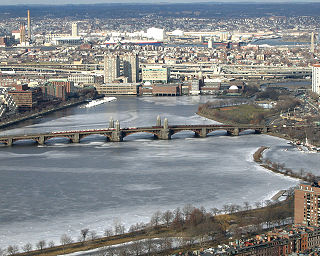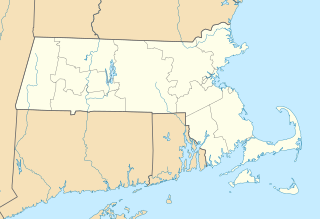
Kenmore Square is a square in Boston, Massachusetts, United States, consisting of the intersection of several main avenues as well as several other cross streets, and Kenmore Station, an MBTA subway stop. Kenmore Square is close to or abuts Boston University and Fenway Park, and it features Lansdowne Street, a center of Boston nightlife, and the Citgo sign. It is also the eastern terminus of U.S. Route 20, the longest U.S. Highway.

The Middlesex Canal was a 27-mile (44-kilometer) barge canal connecting the Merrimack River with the port of Boston. When operational it was 30 feet wide, and 3 feet deep, with 20 locks, each 80 feet long and between 10 and 11 feet wide. It also had 8 aqueducts.

Saxonville is a historic mill village located in the north end of the city of Framingham, in Middlesex County, Massachusetts 01701.
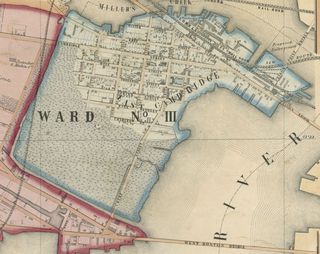
East Cambridge is a neighborhood of Cambridge, Massachusetts. Referred to in modern times as Area 1, East Cambridge is bounded by the Charles River and the Charlestown neighborhood of Boston on the east, the Somerville border on the north, Broadway and Main Street on the south, and the railroad tracks on the west. Most of the streets form a grid aligned with Cambridge Street, which was laid out to directly connect what is now the Charles River Dam Bridge with what in 1809 was the heart of Cambridge, Harvard Square. The northern part of the grid is a roughly six by eight block residential area. Cambridge Street itself is retail commercial, along with Monsignor O'Brien Highway, the Twin Cities Plaza strip mall, and the enclosed Cambridgeside Galleria. Lechmere Square is the transportation hub for the northern side. The southern half of the grid is largely office and laboratory space for hundreds of dot-com companies, research labs and startups associated with MIT, biotechnology firms including Genzyme and Biogen, the Athenaeum Press Building, light industry, an NRG Energy power station, and various small businesses. This half of the neighborhood is generally identified with Kendall Square. Along the waterfront are several hotels and taller apartment buildings.
The Malden River is a 2.3-mile-long (3.7 km) river in Malden, Medford, and Everett, Massachusetts. It is roughly 675 feet (206 m) wide at its widest point and is very narrow at its smallest point. Its banks are largely occupied by industrial business, and the river is scarcely used or even mentioned. Its water quality is worse than most local waters, including the Mystic River, into which it flows.

North Billerica is an unincorporated village of the town of Billerica, Massachusetts, United States, one of the nine sections (hamlets) that make up the Town of Billerica. It is the home to Faulkner and Talbot mills and the North Billerica Train Depot. The Middlesex Canal was built through the village in 1783 and the Boston and Lowell Railroad was put through in the 1840s.
The Federal Dam is a manmade dam built across the Hudson River in the U.S. state of New York from Troy on the east bank to Green Island on the west bank. The major function of the dam is to improve navigability. It is located at mile 153 of the Hudson River, measuring from the beginning of the Hudson as a Federally Navigable Waterway near the Battery in Manhattan. The location of the dam marks the upper end of the Hudson River estuary.

The Quaboag River is a 25.7-mile-long (41.4 km) river in Massachusetts that heads at Quaboag Pond in Brookfield at an elevation of 594 feet (181 m) above sea level. It flows west to the village of Three Rivers, Massachusetts, at an elevation of 290 feet (88 m).

The Sudbury River is a 32.7-mile-long (52.6 km) tributary of the Concord River in Middlesex County, Massachusetts, in the United States.

Lechmere Canal is a short canal in East Cambridge, Massachusetts. It opens onto the Charles River and used to be an active port for Boston Harbor and the Atlantic Ocean.
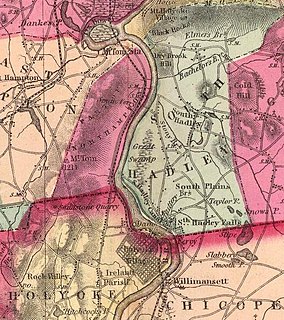
The South Hadley Canal was a canal along the Connecticut River in South Hadley, Massachusetts. It is said to be the earliest navigable canal in the United States, with operation commencing in 1795. It has been listed on the National Register of Historic Places as the South Hadley Canal Historic District.

The Turners Falls Canal, also historically known as the Montague Canal, was a canal along the Connecticut River in Montague, Massachusetts. It was reconstructed in 1869.

The Merrimack Canal is a power canal in Lowell, Massachusetts. The canal, dug in the 1820s, begins at the Pawtucket Canal just above Swamp Locks, and empties into the Merrimack River near the Boott Cotton Mills. The Merrimack Canal was the first major canal to be dug at Lowell exclusively for power purposes, and delivered 32 feet (9.8 m) of hydraulic head to the mills of the Merrimack Manufacturing Company. The Merrimack Manufacturing Company was the first of the major textile mills constructed in Lowell. It was demolished around 1960.

The Holyoke Canal System is a system of power canals in Holyoke, Massachusetts. It is split into three canals based on elevation and distance from the inlet at the Holyoke Dam- the First Level Canal, Second Level Canal, and Third Level Canal. Constructed over a period between 1848 and 1892, the Canal System, along with the Dam, is recognized as a Historic Mechanical Engineering Landmark by the American Society of Mechanical Engineers for its use in the development of the Venturi meter by Clemens Herschel, the first means of measuring large-scale flows, and the McCormick-Holyoke Turbine by John B. McCormick, which doubled the efficiency of turbines to more than 80% in its time.
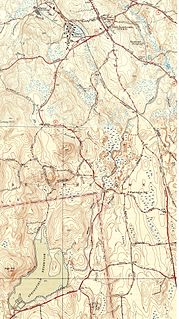
The Broad Brook Canal is a water-supply canal feeding the Springfield Reservoir in Ludlow, Massachusetts, a public water supply for the city of Springfield, Massachusetts. Its northern segment is also known as the Jabish Canal.

North Point Park is an 8.5-acre (3.4 ha) park located on the Charles River in Cambridge, Massachusetts, created as mitigation for the taking of planned parkland for the construction of the Big Dig. The park opened in December 2007. It is part of the "lost half mile" of the Charles River, between the 1910 Charles River Dam, now the site of the Museum of Science and the new Charles River Dam completed in 1978. The park opening was delayed for several years by a number of logistical and bureaucratic issues, but its design, including small islands, bridges and kayaking canals, has been characterized as "grand" and "ambitious" by the local press. The park was designed by Carr Lynch & Sandell of Cambridge and Oehme, van Sweden & Associates of Washington, DC. The park is adjacent to the ongoing NorthPoint real estate development project. Just upstream of these three new parks is the Paul Dudley White Bike Path in the Charles River Reservation. The Lynch Family Skate Park is located in North Point Park under the Interstate 93 highway ramps.

The North Canal Historic District of Lawrence, Massachusetts, encompasses the historic industrial heart of the city. It is centered on the North Canal and the Great Stone Dam, which provided the waterpower for its many mill complexes. The canal was listed on the National Register of Historic Places in 1975, while the district was first listed in 1984, and then expanded slightly in 2009.

Pawtucket Falls is a waterfall on the Merrimack River at Lowell, Massachusetts. The waterfall and rapids below it drop a total of 32 feet in a little under a mile, and was an important fishing ground for the Pennacook Indians in pre-colonial times.

Stony Brook is a stream largely running through Weston, Massachusetts, then forming the Weston/Waltham boundary, and emptying into the Charles River across from the Waltham/Newton boundary. It has two tributaries, Cherry Brook and Hobbs Brook, and its watershed includes about half of Lincoln and Weston as well as parts of Lexington and Waltham. Since 1887, it has been the water supply for Cambridge.

The Amelia Earhart Dam is an earth-fill dam spanning the Mystic River near its mouth between Somerville and Everett, Massachusetts. It was built in 1966 to regulate tidal effects and the incursion of salt water in the upstream river basin. It has 3 locks for marine traffic. The largest is 325 feet long, and 45 feet wide; the two smaller locks are 120 feet long and, 22 feet wide. There is no public access to the dam.


